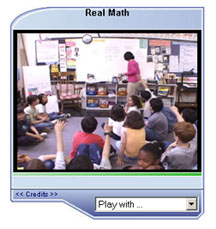 How it works: How it works:
The students involved in this unit of study will have many opportunities to explore geometric solids (polyhedra). Working together in small cooperative groups, they will sort polyhedra according to their attributes. This process of observing similarities and differences will allow children to learn the components of these shapes and how they are related. They will become familiar with a common mathematical vocabulary that they will use throughout this unit.
Children will also begin to look at their real world through the eyes of a mathematician. They will identify geometric solids in the real world and again use their learned vocabulary to describe what they see.
Students will play a game called "Guess My Solid" – where they will ask questions about the attributes of a hidden shape in order to figure out which shape it is. Through a process of elimination, students should be able to name the mystery solid. This activity reinforces their knowledge of the characteristics of these shapes as well as the use of geometric vocabulary. In addition, as students become more familiar with the attributes of the geometric solids, they are more skilled at figuring out the mystery shape!
When students build their own models of polyhedra they think about how many sides, vertices, and faces their shape has. In this activity students look at flat representations of polyhedra and they need to make the
three-dimensional shape. Again, their knowledge of the attributes of the polyhedra is reinforced. Students also continue to see the relationship between different polyhedra when they are physically building
them.
Standards addressed by this unit:
The NYS Science Education Standards which apply to the lessons include:
-
The student will use many types of figures and
identify the figures by their properties
-
The student refers to geometric shapes and terms correctly with concrete objects or drawings (i.e., vertex, edge, polygon, triangle, rectangle).
-
The student visualizes and represents two- and three-dimensional views of various polyhedra.
-
The student solves problems by showing relationships between and among geometric figures.
Materials used:
-
Sets of wooden geometric solids. Each solid needs to be labeled with a letter so that we can refer to them
(i.e. label all triangular prisms “A”) – 1 set per group of 4-5 students.
-
Building materials such as straws, toothpicks, and connectors (such as jelly beans or small marshmallows).
-
Paper for recording
-
Prepared worksheets
Students:
The students involved in this project were a heterogeneous group of third graders with varying mathematical abilities. The students have had prior experience in the lower grades working with 2 dimensional shapes (i.e. pattern blocks) and had knowledge of common geometric vocabulary (square, triangle, rectangle, circle). Although their vocabulary of solid geometric shapes (3-D) was limited, the children have had many experiences building with blocks as well as experience with solids in the lower grades.
Overall Value:
Geometry is everywhere in the real world. The bed
in which you sleep, the book you hold, the ice cream cone you eat are all geometric. Children come to this study with a natural excitement because it is so related to everything around them. Students who do not see themselves as successful mathematicians—because they struggle with number concepts—are successful in this unit. Working with
manipulatives, students become careful observers and develop the ability to see relationships between different geometric solids. Through cooperative learning experiences children learn a shared vocabulary and conduct sophisticated mathematical conversations. It is exciting to hear children continue mathematical debates way past math time! Students have the opportunity to demonstrate their learning when they create their own models of three-dimensional polyhedra.
Tips:
To enable the teacher to build his/her geometric vocabulary, it would be helpful to have a mathematical dictionary on hand. The dictionary is an excellent resource for helping to answer student queries. Creating enlarged charts with the shapes, their attributes and their names provides a good resource for the children—after their initial
investigations. Have extra jellybeans and marshmallows ready for children to eat after
the building activity!
|

Alice Hom has been at P.S. 6 for 18 years, teaching in the Resource
Room, kindergarten, 2nd, and 3rd grades. Recently, she has served as the math
staff facilitator. She is the recipient of past IMPACT II Adaptor and Developer grants. In
addition, she is a National Teacher Policy Institute MetLife Fellow.
E-mail: ahom6145@aol.com
Barbara Rosenblum has been teaching in New York City for the past 12 years. She taught
second grade at P.S. 6 for 10 years, and currently teaches 3rd grade. She is
a Teacher Leader working with other teachers in areas of reading and writing. Barbara was a Resident Teacher in
a former District 2 mentoring program called Professional Development Laboratory. She has learned alongside other teachers at the Teachers College Reading and Writing Institute and has taught at their summer institute.
In addition, she was a former recipient of an
IMPACT II Disseminator Grant.
E-mail: br611@hotmail.com
Estimated class periods to complete: 6
Subject area:
Mathematics
Beginning grade level: 3
Ending grade level: 5
|